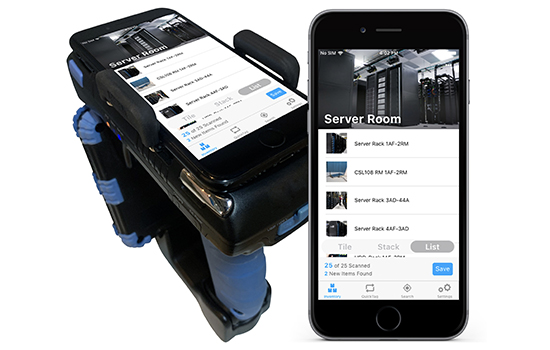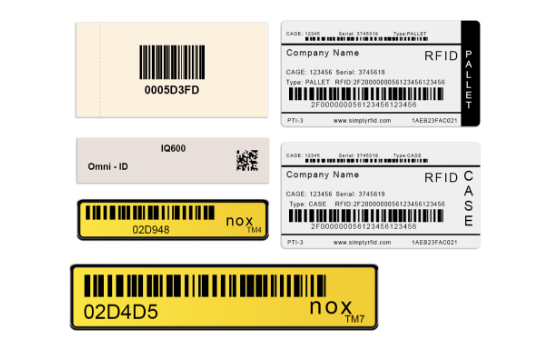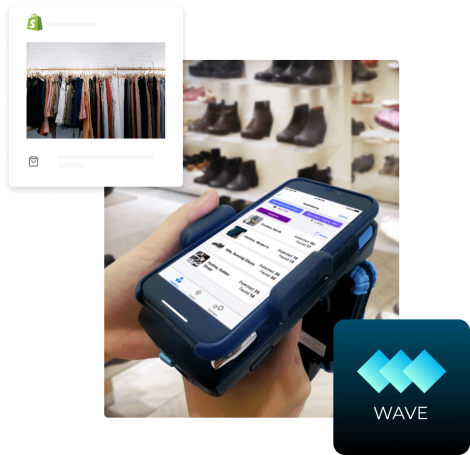Taking inventory of your IT Equipment with RFID

THE PROBLEM
Fewer than 500 assets?
If you're a small company (up to 100 staff), you may have a spreadsheet of your corporate items. Every year, you print out a worksheet, walk around, looking to see where things are. Cost-effective and probably as accurate as you'd be. It's manageable in a 2 hour to 2-day process.
The primary purpose of this audit is for tax reporting: Do we still have all the items we thought we had?
For small companies, where RFID can benefit is in high-value items.
The reason you might add RFID is the ability to audit items daily or hourly. For most businesses, this is not a requirement. Most business PCs have low street value, and theft/loss isn't a concern.
Examples
- iPads: A restaurant may issue iPads / iPods to staff for ordering or as an electronic menu. A fast check-in/check-out with RFID makes dealing with 100 iPods a snap. The limit on human memory is around seven items.. After that, we forget. RFID allows you to manage valuable IT assets in seconds, accurately.
The limit on human memory is seven items. Plus or minus two items. - George Miller, Psychologist, 1956 -- RFID Processes more than 100 items every second
- IT AV Equipment or loaner items: You may have a toolkit with $20,000 in parts. A line tester, expensive crimp tools, a scope, and multimeter designed to troubleshoot areas. This rolling loot piñata is easy for end-users to knock off items. Not intentionally, per se, but who doesn't covet the $200 Fluke multimeter over that $29 Amazon special?
Audit time for ITAM Parts Return
The idea is to automate inventory and make audits easy. Before RFID, it wasn't possible to remember what was missing. Why? Because you have more than seven things to remember. Your brain just simply isn't meant for this. RFID is.
Let's look at the ROI for RFID. Here are the parameters:
- It takes 15 seconds to scan a barcode
- 0.1 seconds per RFID tags (10 per second)
- Five days per week / 250 days per year
- Totaly yearly audit time required calculated
Time Savings
| Items per day | Barcode Time | RFiD Time | RFID Each Event |
|---|---|---|---|
| 100 | 104 Hours | 45 Minutes | 10 seconds |
| 500 | 520 Hours | 3.5 Hours | 1 Minute |
| 2000 | 2,083 Hours | 14 Hours | 3 Minutes |
If your organization doesn't plan to use RFID 'daily' - it won't be cost-effective on a small scale. In our example, if you have five work trucks/carts with 20 items each, that's 100 items per day to scan in/out. Two hundred fifty daily audits per year—25,000 item events.
Frankly, it's not possible with a barcode. You can try a barcode sign in/out system. It's too stolid. Too cumbersome. People will not use it. With RFID, you can also automate the process -- but that's a different topic using fixed RFID readers, and we will go into that in another how-to.
500 - 50,000 Asssets
Once your company reaches 500+ assets, your company is probably looking at leases, warranties, product life expectancies.
You're probably putting some permanent asset tags on each item and updating a 'fixed asset register.'
The great thing about using RFID vs. regular barcode labels is that it's not more complicated, and it returns over-and-over when it's time to audit the equipment. Additionally, with RFID, you can add doorway audits and track with automated tracking systems like Pogi.
Add an RFID tag, and your audit times will drop by more than 95%. Our SimplyRFiD Wave Handheld will get you started tomorrow.
Audit time
ROI parameters:
- It takes 15 seconds to scan a barcode
- 0.1 seconds per RFID (10 per second)
- Totaly audit time required, once per year
| Items | Barcode Time | RFiD Time |
|---|---|---|
| 1,000 | 4 Hours | 3 Minutes |
| 10,000 | 41 Hours | 28 Minutes |
| 100,000 | 416 Hours | 3 Hours |
With RFID, it's possible to do asset audits daily.
These numbers are for a single person performing the audit. With fixed, automated readers, this can be even faster.
50,000+ Assets
Here is where RFID is invaluable. At this point, you'd be moving to a global, automated RFID inventory system based on our Pogi server and fixed RFID readers.
But, let's not confuse fixed-assets with inventory here.
Inventory is re-saleable goods—things you manufacture and sell. Many companies produce millions of these per year. Item-level inventory tracking is also a critical part of the future item-level supply chain - but has different needs. We wrote a how-to for RFID inventory, also, to look more at the problems in managing for-sale inventory. And, if you're thinking of item-level RFID, we have built Item Level RFID systems since 2008. Enjoy our first video on it -- when Carl had hair.
Typically at 50,000+ assets, you'll be looking at EAM (Enterprise Asset Management) systems. RFID can provide visibility into those systems (like ServiceNow or Snow). Look for an article later detailing how to add real-time visibility.

THE SOLUTION
RFID makes counting your IT equipment easy, fast, and super-accurate.
Typically, you would tag your IT equipment with a corporate 'asset tag' when installing or receiving the item. RFID is the same. You'll use an RFID tag as your asset tag. Associate the item to the tag number.
The difference is all in the audit step. When you use regular barcode or number based asset tags, you don't gain long term speed benefits. Barcodes are great for accuracy, but they don't account for the labor costs that RFID offers.
Cost Savings for RFID
Tags
| Tag | Cost |
|---|---|
| Barcode Asset Tag | $0.10 |
| SimplyRFiD RAIN RFID Tag | $1.00 |
| Cost Difference | $0.90 ($2,700 on 3,000 tags) |
Audit time
Assuming the loaded rate for an IT Support Tech: $70
| Audit | Time | Cost |
|---|---|---|
| Barcode @ 15 seconds per tag | 12.5 Hours | $875 per inventory |
| RFID @ 10 tags per second | 5 minutes | $6 per inventory event |
Assuming a quarterly inventory, RFID will break-even in its first year with 3,000 assets. And, will begin payback in future years and allow add-ons like automated tracking and surveillance.
Of course, you'll still need to locate missing items. But, RFID can also record item movement automatically by installing fixed RFID readers.
Automating your IT Tracking
But what if you want to get better control of your assets?
IT Equipment Rooms
The most likely first step is an IT equipment room. In this room, you may be storing new laptops for distribution, AV equipment, accessories.
Letting someone in to pick what they like may result in users selecting the incorrect equipment or taking 'early upgrades.' Losing control of equipment distribution will break the budget for your IT team. But, you'll want a day off at some point, and someone will need a new mouse.
A quick automated inventory tracker:
- Place an fixed RFID reader at your exit.
- Place antennas inside and outside your secure room.
- RFID Readers connected to our Pogi server will keep track of items that move from the room to the outside world. You can add notifications when items move from each location. With a timestamp, you can look at the video to see who took an item.
Doorways / Egress
To secure items, you can place fixed RFID readers around doorways. Alarms will buzz and light up when an event occurs -- like a controlled item approaching the door.
Tagging IT equipment or critical corporate documents with RFID tags vs. traditional barcodes allows this newfound ability.
However, no RF system works on its own. Where these things work best is if you have a security team at the door. When personnel approach, they must open their bag for inspection. RFID will identify items for the security team. If you rely on RFID only, thieves will eventually create a faraday cage bag that can shield the RFID tags from view. RFID is a tool for confirmation and speed. It can not replace a security team.

THE PROCESS
RFID Tags
Please take a look at our TM4 RFID tags for metal-cased items. These are durable, small tags (4 centimeters / 1 inch) and only work on metal surfaces. The TM7 has a better range if there is room for a larger tag. And, the TM7 works on all surfaces equally well.
The TA454 is excellent if you don't know the surface (metal, glass, plastic, or cardboard). They are a bit larger, but they work on everything and have a very low profile (about as thick as a credit card.) The biggest issue is they are often too wide on smaller IT equipment. They do work great on every laptop.
Finally, our TR800 RFID tag is great on plastic-front items. They are a low-cost option if you've got a plastic bezel. Warning: Many computers will have plastic exterior but have a thin metal interior frame. Hidden metal can interfere with the TR800 tag.
Tagging
-
Place the RFID tag on the item.
-
Use the Wave handheld to scan the serial number or model number. Use the built-in barcode scanner to add serial numbers quickly.
-
Wave works with our Pogi Server to exchange and store all your data center information.
Auditing
Once you've tagged your items, it's easy to select a location, scan your RFID Tags, and see 'what's missing.'
Take a look at our manuals for Pogi and Wave.

